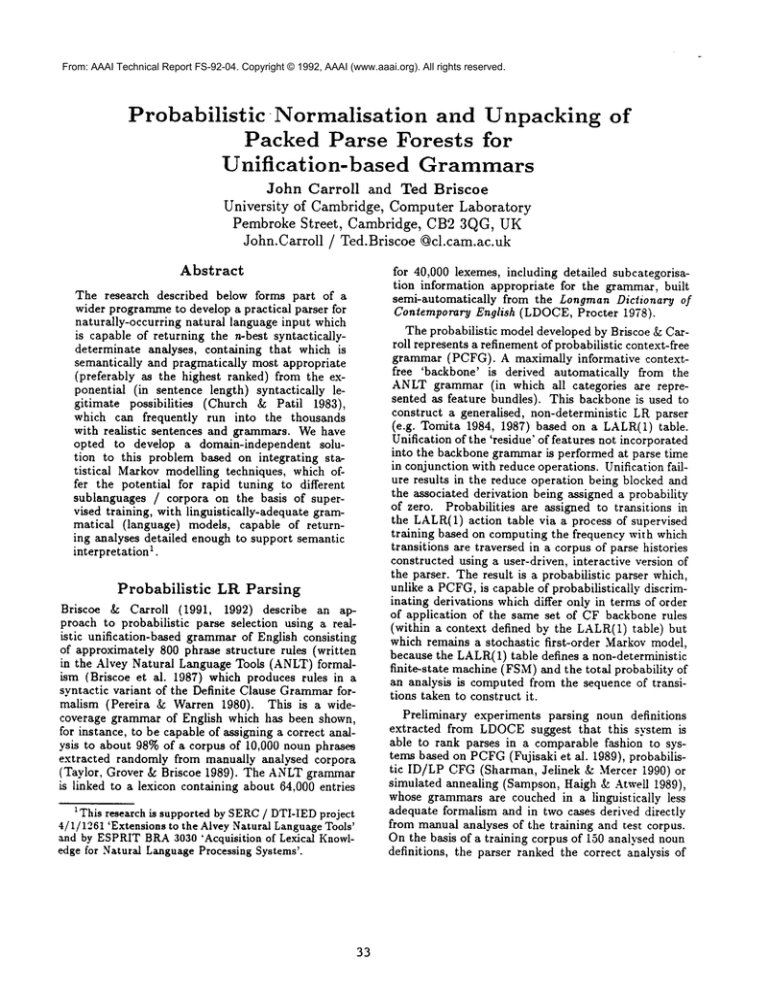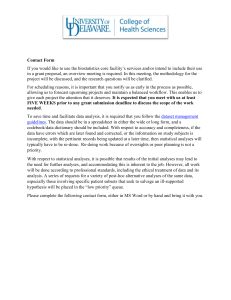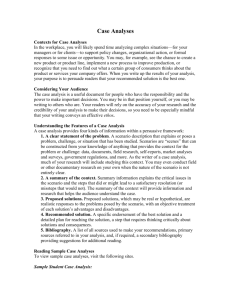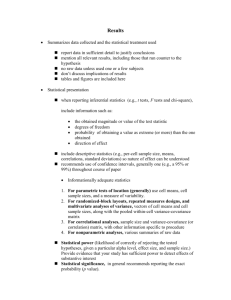
From: AAAI Technical Report FS-92-04. Copyright © 1992, AAAI (www.aaai.org). All rights reserved.
Probabilistic
Normalisation
and Unpacking
Packed Parse Forests for
Unification-based
Grammars
of
John Carroll
and Ted Briscoe
University
of Cambridge, Computer Laboratory
Pembroke Street,
Cambridge,
CB2 3QG, UK
John.Carroll
/ Ted.Briscoe
@cl.cam.ac.uk
Abstract
The research described below forms part of a
wider programmeto develop a practical parser for
naturally-occurring natural language input which
is capable of returning the n-best syntacticallydeterminate analyses, containing that which is
semantically and pragmatically most appropriate
(preferably as the highest ranked) from the exponential (in sentence length) syntactically legitimate possibilities
(Church & Patil 1983),
which can frequently run into the thousands
with realistic
sentences and grammars. We have
opted to develop a domain-independent solution to this problem based on integrating statistical
Markov modelling techniques, which offer the potential for rapid tuning to different
sublanguages / corpora on the basis of supervised training, with linguistically-adequate grammatical (language) models, capable of returning analyses detailed enough to support semantic
I.interpretation
Probabilistic
LR Parsing
Briscoe & Carroll (1991, 1992) describe an approach to probabilistic parse selection using a realistic unification-based grammarof English consisting
of approximately 800 phrase structure rules (written
in the Alvey Natural Language Tools (ANLT)formalism (Briscoe et al. 1987) which produces rules in
syntactic variant of the Definite Clause Grammarformalism (Pereira & Warren 1980). This is a widecoverage grammar of English which has been shown,
for instance, to be capable of assigning a correct analysis to about 98%of a corpus of 10,000 noun phrases
extracted randomly from manually analysed corpora
(Taylor, Grover & Briscoe 1989). The ANLTgrammar
is linked to a lexicon containing about 64,000 entries
I Thisresearch
is supported
by SERC/ DTI-IED
project
4/I/1261
’Extensions
totheAlveyNatural
Language
Tools’
andby ESPRITBRA3030’Acquisition
of Lexical
KnowledgeforNatural
Language
Processing
Systems’.
33
for 40,000 lexemes, including detailed subcategorisation information appropriate for the grammar, built
semi-automatically
from the Longman Dictionary of
Contemporary English (LDOCE,Procter 1978).
The probabilistic model developed by Briscoe & Carroll represents a refinement of probabilistic context-free
grammar (PCFG). A maximally informative contextfree ’backbone’ is derived automatically from the
ANLTgrammar (in which all categories are represented as feature bundles). This backbone is used to
construct a generalised, non-deterministic LRparser
(e.g. Tomita 1984, 1987) based on a LALR(1)table.
Unification of the ’residue’ of features not incorporated
into the backbone grammar is performed at parse time
in conjunction with reduce operations. Unification failure results in the reduce operation being blocked and
the associated derivation being assigned a probability
of zero. Probabilities are assigned to transitions in
the LALR(1)action table via a process of supervised
training based on computing the frequency with which
transitions are traversed in a corpus of parse histories
constructed using a user-driven, interactive version of
the parser. The result is a probabilistic parser which,
unlike a PCFG,is capable of probabilistically discriminating derivations which differ only in terms of order
of application of the same set of CF backbone rules
(within a context defined by the LALR(1)table)
which remains a stochastic first-order Markov model,
because the LALR(1)table defines a non-deterministic
finite-state machine (FSM)and the total probability
an analysis is computed from the sequence of transitions taken to construct it.
Preliminary experiments parsing noun definitions
extracted from LDOCEsuggest that this system is
able to rank parses in a comparable fashion to systems based on PCFG(Fujisaki et al. 1989), probabilistic ID/LP CFG(Sharman, Jelinek & Mercer 1990)
simulated annealing (Sampson, Haigh & Atwetl 1989),
whose grammars are couched in a linguistically
less
adequate formalism and in two cases derived directly
from manual analyses of the training and test corpus.
On the basis of a training corpus of 150 analysed noun
definitions, the parser ranked the correct analysis of
From: AAAI Technical Report FS-92-04. Copyright © 1992, AAAI (www.aaai.org). All rights reserved.
a sample of 89 sentences from the training corpus as
most probable in 76% of cases, and ranked the correct analysis as most probable in 75%of a further 55
test sentences from the same corpus. These results
were achieved solely on the basis of statistics concerning the conditional probability of syntactic rules in
a syntactically-defined (LR) parse context, therefore
a significant number of errors involved incorrect attachment of PPs, analyses of compounds, coordinations, and so forth, where lexical (semantic) information plays a major role. In manyof these cases, the correct analysis was in the three highest ranked analyses.
Both Sharmanet al and Fujisaki et al. achieve slightly
better results (about 85% correct parse / sentence),
but their grammars integrate information concerning
the probability of a lexemeoccurring as a specific lexical syntactic category. Using a tree similarity measure,
such as that of Sampsonet al., the most probable analyses achieve a better than 96%fit to the correct analyses (as opposed to 80%for Sampsonet al.’s simulated
annealing parser).
We intend to extend this system in a number of
ways to integrate the probability of a lexeme occurring with a specific lexical syntactic (sub)category, the
probability of structurally-defined collocational patterns and statistical rule induction techniques to deal
with cases of undergeneration (e.g. Briscoe & Waegner
1992). However, in this paper we address two more
specific and related issues concerning the probabilistic
interpretation of the system: firstly, the appropriate
method of combining the probability of (partial) analyses, and secondly, a method for tractably computing
the n-best analyses from the complete set licensed by
the grammar.
shawi 1992). The parser constructs a packed parse
forest representation of the complete set of analyses licensed by the ANLTgrammar for a given input. In
this representation identical sub-analyses are shared
between differing superordinate analyses (as in chart
parsing and other tabular parsing techniques) and subanalyses covering the same portion of input are packed
if the subsumption relation defined on unificationbased formalisms holds between their root categories.
In a probabilistic packed parse forest the probabilities
of sub-analyses are associated with each node in the
forest and in the case of packed nodes a distinct probability is maintained for each distinct sub-analysis at
that node. Although this approach can be exponential
in sentence length for some relatively unnatural grammars (Johnson 1989), in practice we have been able
to generate packed parse forests for sentences containing over 30 words having many thousands of analyses. Schabes (1991) describes a Earley-like context-free
LI~ parsing algorithm that is guaranteed polynomial in
sentence length; however, a unification grammarversion of this turns out to be exponential for some types
of grammar, since on each reduce action the daughters
of the rule involved in the reduction have to be unified
with every possible alternative sequence of the subanalyses that are being consumedby the rule. Our conclusion from experiments we have carried out with an
implementation of the algorithm is that for the ANLT
it offers no advantages over a Tomita-style parser.
Although we are able to generate packed parse
forests for relatively long sentences, our previous technique for unpacking these forests to find the n-best
analyses was not optimal since it involved a frequently
near exhaustive search of the forest and was. therefore, exponential in the length of the input. UnsurProbabilistic Packed Parse Forests
prisingly, this was the major source of computational
intractability in our system and for sentences of over 20
Ideally,
thecomputation
of themostprobable
analysisor then-bestanalyses
defined
by ourprobabilistic words often led to system failure. It is not straightforward to optimise this computation because once again
LR parsershouldnotinvolve
exhaustive
searchof the
remaining unifications involving the different featural
spaceof syntactically
legitimate
analyses
defined
by
extensions of packed nodes according to the superorthe ANLTgrammarfor any giveninput.However,it
dinate and subordinate nodes to which they can be
is notpossible
to introduce
anyViterbi-style
optimilinked can lead to failure of a derivation encoded in
sationintothe computation
of localmaximalpaths
the parse forest, unlike in the case of unpacking PCFG
throughtheprobabilistic
non-deterministic
FSM depacked parse forests (e.g. Wright, Wrigley ~z Sharman
finedby the parsetable,becauseat anypointin a
derivation
a maximalpathmay receivea probability 1991) where Viterbi-style optimisation is possible.
of zerothrough
unification
failure,
rendering
a hithIn a stochastic modelthe probability of a (sub-) analertonon-maximal
localpath maximalagain.Unforysis should be the product of the probability of the
tunately,
theeffects
of feature
propagation
cannotbe
analyses combinedto construct it. There are, however,
localised
withrespect
to thecomputation
of mostprobproblems with using this measure to compare analyses
ablesub-analyses,
whilstanyattempt
to incorporate produced by LR parsers because LP~ parse tables defeatural
information
intotheprobabilistic
component fine FSMswhich are not ergodic, and non-deterministic
of thegrammarwouldresulteitherin an intractably LR parsers need not be time synchronous (contrary to
large grammar, or a model with too many free paramconventional practice in (hidden) Markov modelling).
eters, or both.
In practice, this means that at any point during parsOur parser is based on Kipps’ (1989) LRrecogniser
ing it is difficult to evaluate all competing analyses
(a re-formulation of Tomita’s (1984, 1987) algorithm),
for the same portion of input because these may not
generalised for the case of unification grammars(AIall be available and may involve differing numbers of
34
From: AAAI Technical Report FS-92-04. Copyright © 1992, AAAI (www.aaai.org). All rights reserved.
statetransitions
in theLR table(corresponding
to the
’depth’
of theresultant
syntactic
tree).In previous
work(Briscoe
& Carroll1991,1992)we attempted
avoidthisproblemby computing
thegeometric
mean
of each(sub-)analysis
of a giveninputandonlycomparingthegeometric
meansforcomplete
analyses,
followingMagerman& Marcus(1991).Usinggeometricmeans,as opposedto products,
achieves
a crude
formofnorrnalisation
withrespect
tothelength
of the
derivation.
Morerecently
we havebeenexperimenting
witha methodof normalisation
witha clearer
probabilistic
interpretation,
described
below.
whichpointalltheanalyses
willbe complete
andwill
endat therootnodeof theforest.
Theseanalyses
are
returned
as them-bestset.
A partial
analysis
is takento endat thehighest
node
whichdominates
thelexical
nodeat therightedgeof
theanalysis
butwhichdoesnotdominate
thenextlexicalnodeto theright;
or alternatively
at therootnode
if thereareno further
wordsin theinput.Forexample,thepartial
analyses
fromvertexzeroto vertex2
in thepackedforest
shownin figure
1 endat theboxed
nodeslabelled
II/COMP
and N. Figure2 showsthetwo
analyses
whicharerepresented
in theforest.
Sinceour
parser
usesa shift-reduce
strategy,
it constructs
rightProbabilistic Unpacking and
most-first
derivations
of theinput.
A partial
analysis
Normalisation
thusconsists
of one or moresubtrees
whoseheights
decrease
whenlooked
at fromleftto right.
Although
no Viterbi-style
optimisation
is possible
duringthe courseof parsing(sincea hitherto
maximal
Eachnodein theforestcontains
thenumberandthe
2 takenup to
pathmaybe subject
to a unification
failure
andthus
product
of theLR parsetabletransitions
mustbe abandoned),
thetechnique
canjustifiably
be
thatpointin theanalysis
of thesubtree
dominated
by
applied
to theprobabilistic
packedparseforestonce
the node.Whenextending
a partialanalysiswitha
parsingis complete.
Our approach
is firstto connewsubtree,
thetransition
countandproduct
figures
struct
a parseforest
representing
thefullsetofanalyforthenewextended
analysis
dependon therelationseslicensed
by thegrammar,
andthento identify
the
shipbetween
theheights
of nodesat therootsof the
m-best
analyses
intheforest
witha probabilistically-subtrees currently making up the partial analysis and
guidedsearch,
simultaneously
normalising
thescores
the height of the new (extending) subtree. If the root
forpartial
analyses
ofidentical
portions
oftheinput.
node of the newsubtree is closer to the root of the forThebestm complete
analyses
thathavebeenidentiest than some of the current ones, then it dominates
fiedare thenunpacked
fromtheforest,thisprocess
them, and so the figures for the extended analysis are
involving
a smallnumberof further
unifications.
The
those of the new node combined as appropriate with
analyses
forwhichtheseunifications
allsucceed
arerethose of nodes in the partial analysis which preceded
turned.
If thenumber
of analyses
returned
is lessthan
the dominated nodes. Otherwise a disjoint subtree is
the n wanted,the processcouldbe repeatedwitha
being added to the right edge of the partial analysis,
larger
valueform.
and the figures at the new node are combined with
In practice,
thisapproach
leadsto a considerable those for all the current nodes. Packed nodes must be
practical
improvement
in the timetakento produce
dealt with specially since the figures at a node take no
thea-bestanalyses.
Although
the algorithm
remains
account of nodes which are packed below it. In fact,
in the worstcaseexponential
in sentence
length,
in
it suffices to keep track of the differences between the
practice
it willneverneedto search
morethana fracfigures at a node and those at the root of a subtree
tionof thepacked
parseforest
to recover
thebestanalpacked at that point whenever the subtree is incoryses(except
in thecaseof pathological
grammars).
porated into a partial analysis, and to factor in these
addition,
by separating
theprobabilistic
computation differences whenever the figures at a node are subsefromthecreation
of theparseforest,
we avoidsomeof
quently required.
theproblems
induced
by thenon-local
natureof feaIn the implementation, the parse tree corresponding
turepropagation.
to a partial analysis is represented implicitly by the set
of packed nodes that it contains; when the probabilisIdentifyingthe Best Partial Analyses
tic search of the parse forest is finished, the actual tree
Our technique
foridentifying
thebestanalyses
in a
is unpacked from the forest in an efficient depth-first
probabilistic
packedparseforestinvolves
maximising traversal. Nodes at which there is no packing, or at
the(normalised)
scoreat nodesin theparseforest,
which none of the packed nodes are in the given set,
a similar
mannerto theViterbi
algorithm.
Themethod
are incorporated into the tree. Packed nodes which are
starts
attheleftedgeoftheforest
(atvertex
zero),
members
of the set are incorporated, after performing
eachsuccessive
stepnorrnalising
(asdescribed
below)
the unification required to check that they are consistheprobabilities
assigned
to allpartial
analyses
from
tent with the rest of the analysis built so far, and the
vertices
zeroto v whichendat thesamenodein the
traversal continues inside the packed subtree.
forest,
andthenextending
justthem bestpartial
analysesat eachnodeto reachvertexv + I. Theprocess
stopsafterpruningthelowestscoringanalyses
when
2In fact what is stored is the sumof the logarithms of
thevertex
v isjustafterthelastwordin theinput,
at
the transitions.
35
From: AAAI Technical Report FS-92-04. Copyright © 1992, AAAI (www.aaai.org). All rights reserved.
N/COMP
Ellipses
nodes.
enclose packed
Boxes mark end nodes
of partial analyses from
vertices 0 to 2.
Figure 1: A Packed Parse Forest.
NICOMP
N
[ N/qO~[
/\
N
N/COMP
N
N/COMP
N
Figure 2: Analyses that are Represented in the Forest.
Normalising
Partial
Analyses
Since partial analyses spanning the same vertices may
well have been derived via differing numbers of LR
state transitions, scores for competing analyses must
be normalised before they can be compared and the
best ones identified.
Wehave experimented with two
alternative normalisation methods.
The first methodis to normalise the scores of all the
partial analyses which end at a given node in the forest to the length of the longest derivation in any of
those analyses; for each derivation that is shorter by
say d transitions, its score is multiplied by the geometric mean of the score raised to the power of d. So, for
example, if at one stage the longest derivation was of
length 5, two other derivations of length 3 and 4, with
transition
scores
a) 0.9 0.6 0.05
b) 0.5 0.2 0.2 0.08
would be multiphed by factors of 0.09 (= 0.32) for a),
and 0.2 for b) to give normalised scores. This computation can be performed quickly since transition scores
are held as logarithms.
The second, more complex, normahsation method is
to compute the products of the transitions in all the
alternative sequences of transitions which extend partial analyses ending at a given node, to normalise the
products, as above, to the length of the longest sequence, and then to normalise the resulting scores so
that they sum to 1. Next, we assign to each extended
analysis the product of the score for the original partial analysis and the score for the extending transition
sequence. Finally, the scores for all the extended analyses are normalised so they sum to 1. The rationale be-
36
hind this method is that once the parse forest has been
constructed we knowthat all sub-analyses that it contains spanning vertices 0 to v contribute to some successful, complete analysis (modulo unification failure
in the final unpacking). Therefore, we can normalise
the probabilities of all competingsub-analyses for successively increasing portions of the input so that the
sum of their scores is 1. With the additional normalisation that is carried out to take account of differing
derivation lengths, it should be the case that we can
take the product of the probabilities for a partial analysis and one that extends it to obtain the probability
of the extended analysis without introducing unwanted
biases into the resultant ranking.
Empirical
Results
We have re-run the experiment parsing LDOCEnoun
definitions from Briscoe &Carroll (1992) using the new
approach to probabilistically
ranking parses and unpacking the packed parse forest. Using the first normalisation scheme, the results we have obtained are
marginally better than the original ones. Reparsing
the training corpus and automatically comparing the
most highly ranked analysis with the original parse,
for the 89 definitions between two and ten words in
length inclusive (mean length 6.2), in 69 cases the correct analysis (as defined by the training corpus) was
also the most highly ranked. Taking correct parse /
sentence as our measure then the result is 78%, as
compared with 76% originally. Reparsing the further
set of 55 LDOCE
noun definitions not drawn from the
training corpus, each containing up to ten words (mean
length 5.7), in 41 cases the correct parse was the most
From:
AAAI
Technical
ReportaFS-92-04.
1992, AAAI
(www.aaai.org).
All rightsareserved.
highly
ranked,
giving
correct Copyright
parse / ©sentence
meaChoosing
value for
sure of 75%, the same as before. The second normalisation scheme unexpectedly produced much worse results: only 60%of the correct analyses were returned
as the highest ranked when reparsing the training corpus.
Despite the fact that our current implementation of
probabilistic
unpacking is quite crude and could be
speeded up significantly, for a sample of ten-word definitions with up to 150 analyses, the time the implementation takes to return the three highest ranked analyses
fromtheparseforests
isof theorderof a factor
of 3
lessthanintheoriginal
near-exhaustive
searchofthe
forest.
Inthecourse
ofsearching
forthebestanalyses,
on average
onlyabout20%of thenodesin theforests
werevisited.
Forlongerdefinitions
thedifference
is
even moremarked.Our currentimplementation
has
returned
analyses
foreverydefinition
forwhichthe
parsermanaged
to successfully
createa parseforest;
thelongest
suchdefinition
is31 wordsinlength.
Previously,
thelongest
definition
thatwe managed
to return
an analysis
forwas only22 wordslong.We havebeen
unable
to compute
thefullsetof analyses
forthesedefinitions,
dueto spaceandtimeconstraints,
buthave
calculated
thattheyhaveat least2000analyses.
In theexperiments
thatwe havecarried
outso far,
oncetheforest
hasbeensearched
forthehighest
scoringanalyses,
itappears
thatthegreatmajority
ofunifications
thattakeplacewhenunpacking
themaxesuccessful.
In thetestsoutlined
above,
setting
up pruning
of partial
analyses
to discard
allbutthebestthreeat
eachstage,thenumberof finalanalyses
returned
for
each definition was only less than the three required in
the few cases where there were actually less than three
analyses in total.
Conclusions
and Future
Work
In this paper we have presented a technique for probabilistically unpacking a packed parse forest with interleaved normalisation of the scores of partial analyses
covering identical portions of the input. Wehave successfully applied the technique to packed parse forests
created by a unification-based non-deterministic LR
parser, but the technique is generally applicable to
any Tomita-style parse forest created by a shift-reduce
parser in which each node contains sufficient information to be able to compute a normalised probability for
the subtree dominated by the node.
The technique allows our system to return the highest ranked analyses for sentences that are significantly longer than could be coped with using a nearexhaustive search of parse forests; in fact in our experiments the system has been able to return analyses for
every sentence for which a parse forest could be computed. The normalisation methods described in this
paper are also better-founded than the method that
was used previously. However, we are still attempting
to improve the system in this area.
37
m in order to take the m-best
partial analyses at each stage appears to be rather arbitrary. Weare currently investigating changing our
control strategy to take the maximumprobability partial analysis after normalisation and then include all
others in the set of competing sub-analyses which fall
within a given threshold. Then if several analyses had
very similar, high probabilities they would all be returned, and pruning out partial analyses would be dependent on a function of probability likelihood rather
than an arbitrary number.
Acknowledgements
We would like to thank Longman Group Ltd. for allowing us access to the machine-readable version of
LDOCE,and Ann Copestake and Antonio Sanfilippo
for considerable help in the analysis of the LDOCE
noun definition corpus.
References
Alshawi, H. ed. 1992. The Core Language Engine.
MIT Press, Cambridge, Massachusetts.
Briscoe, E. and Carroll, J. 1991. Generalised Probabilistic LR Parsing of Natural Language (Corpora)
with Unification-based Grammars. Cambridge University, Computer Laboratory, TR-224.
Briscoe, E. and Carroll, J. 1992. Generalised Probabilistic LR Parsing for Unification-based Grammars.
Computational Linguistics. Forthcoming.
Briseoe, E. and Waegner, N. 1992. Robust stochastic parsing using the inside-outside algorithm. In Pro¢eedings of the AAAIWorkshopon Statistically-based
Techniques in Natural Language Processing. San Jose,
California.
Briscoe, E., Grover, C., Boguraev, B. and Carroll, J.
1987. A Formalism and Environment for the Development of a Large Grammarof English. In Proceedings
of the 10th International Joint Conference on Artificial
Intelligence, 703-708. Milan, Italy.
Carroll, J. and Grover, C. 1989. The derivation of a
large computational lexicon for English fxom LDOCE.
In Boguraev, B. and Briseoe, E. eds. Computational
Lexicography for Natural Language Processing. Longman, London: 117-134.
Church, K. and Patil, R. 1982. Coping with syntactic
ambiguity or how to put the block in the box on the
table. Computational Linguistics 8: 139-149.
Fujisaki, T., Jelinek, F., Cooke, J., Black, E. and
Nishino, T. 1989. A probabilistic
method for sentenee disambiguation. In Proceedings of the 1st International Workshop on Parsing Technologies, 105-114.
Carnegie-Mellon University, Pittsburgh.
Johnson, M. 1989. The Computational Complexity of
Tomita’s Algorithm. In Proceedings of the 1st Inter-
From: AAAI Technical Report FS-92-04. Copyright © 1992, AAAI (www.aaai.org). All rights reserved.
national Workshopon Parsing Technologies, 203-208.
Carnegie-Mellon University, Pittsburgh.
Kipps, J. 1989. Analysis of Tomita’s algorithm for
general context-free parsing. In Proceedings of the 1st
International Workshopon Parsing Technologies, 193202. Carnegie-Mellon University, Pittsburgh.
Magerman, D. and Marcus, M. 1991. Pearl: a probabilistic chart parser. In Proceedings of the 2nd International Workshop on Parsing Technologies, 193-199.
Cancun, Mexico.
Pereira, F. and Warren, D. 1980. Definite clause grammars for language analysis - a survey of the formalism
and a comparison with augmented transition networks.
Artificial Intelligence 13.3: 231-278.
Procter, P. ed. 1978. The LongmanDictionary of Contemporary English. Longman, London.
Sampson, G., Haigh, R. and Atwell, E. 1989. Natural language analysis by stochastic optimization: a
progress report on Project APRIL. Journal of Experimental and Theoretical Artificial Intelligence 1: 271287.
Schabes, Y. 1991. Polynomial Time and Space ShiftReduce Parsing of Arbitrary Context-free Grammars.
In Proceedings of the 29th Annual Meeting of the Association for Computational Linguistics, 106-113. Berkeley, Ca..
Sharman, R., Jelinek, F. and Mercer, R. 1990. Generating a grammar for statistical
training. In Proceedings of the DARPASpeech and Natural Language
Workshop, 267-274. Hidden Valley, Pennsylvania.
Taylor, L., Grover, C. and Briscoe, E. 1989. The syntactic regularity of English noun phrases. In Proceedings of the 4th European Meeting of the Association for
Computational Linguistics,
256-263. UMIST, Manchester.
Tomita, M. 1984. Parsers for Natural Languages. In
Proceedings of the 10th International Conference on
Computational Linguistics, 354-357. Stanford, California.
Tomita, M. 1987. An efficient
augmented-contextfree parsing algorithm. Computational Linguistics
13.1: 31-46.
Wright, J., Wrigley, E. and Sharman, R. 1991. Adaptive probabilistic generalized LRparsing. In Proceedings of the 2nd International
Workshop on Parsing
Technologies, 154-163. Cancun, Mexico.
38





